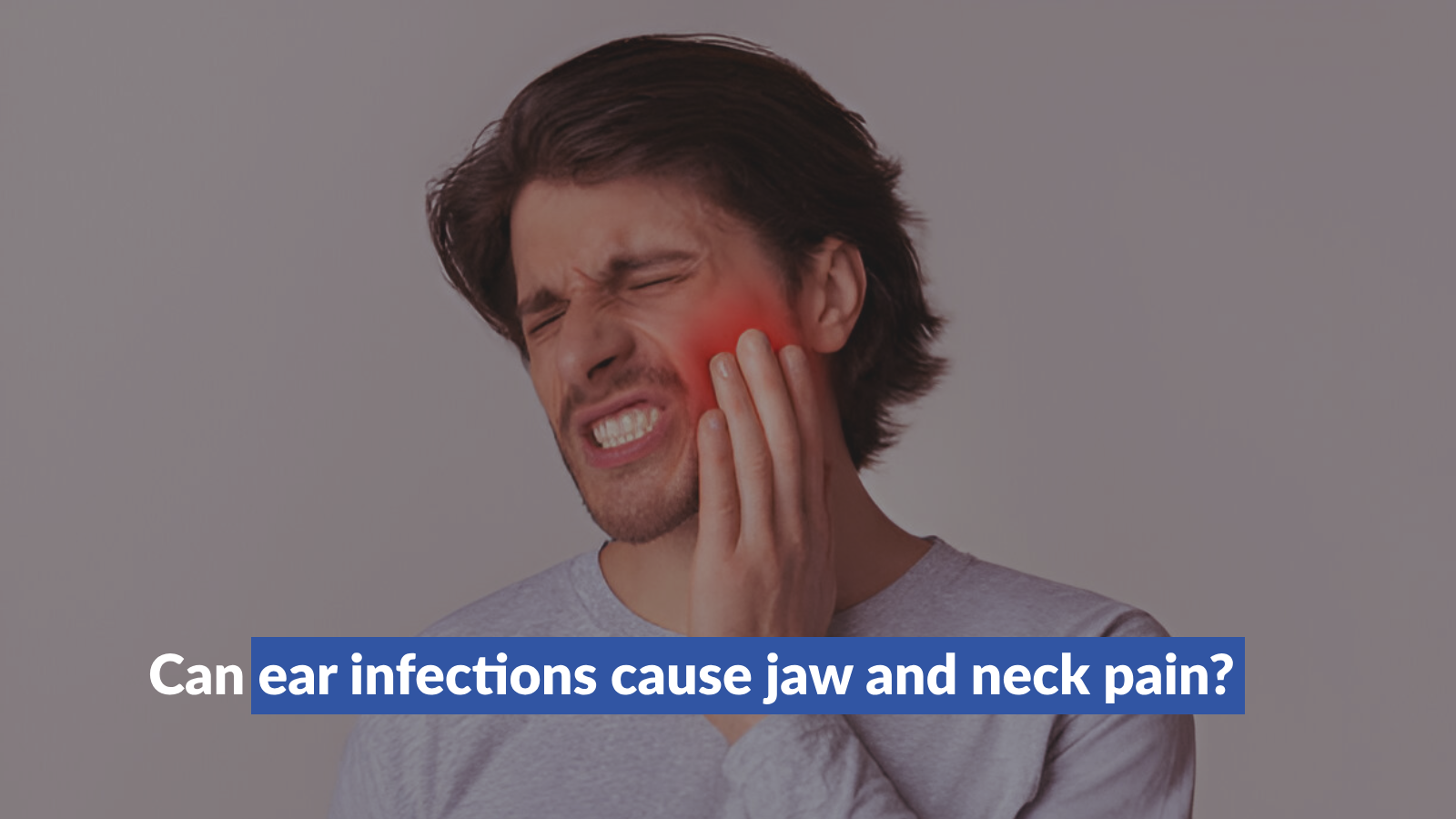When it comes to understanding the effects of an ear infection, it’s crucial to grasp how interconnected our bodily systems are. An ear infection doesn’t just stop at causing discomfort within the ear; it can extend its reach, affecting areas such as the jaw and neck. This article explores the link between ear infections and pain in the neck and jaw, providing insight into symptoms, causes, and treatment options.
Understanding Ear Infections
Ear infections, medically known as otitis media, occur when viruses or bacteria invade the middle ear. The middle ear is the air-filled space behind the eardrum containing tiny vibrating bones. Ear infections can cause pain and discomfort due to inflammation and buildup of fluids. While they are more common in children, adults can also be affected.
Symptoms of Ear Infections
- Ear pain
- Difficulty hearing
- Fluid drainage from the ear
- Fever
- Headache
How Can Ear Infections Cause Neck and Jaw Pain?
The connection between ear infections and neck and jaw pain lies in the anatomy of the head and neck. The ear, jaw, and neck share some of the same nerves and muscles. When an ear infection occurs, inflammation and fluid buildup can put pressure on these shared nerves and muscles, leading to referred pain in the jaw and neck.
Eustachian Tube Dysfunction:
The Eustachian tube connects the middle ear to the back of the throat. Inflammation from an ear infection can cause the tube to swell, leading to neck and jaw pain.
Trigeminal Nerve Involvement:
The trigeminal nerve, responsible for facial sensation and motor functions such as biting and chewing, can be affected by the pressure and inflammation of an ear infection, causing neck and jaw pain.
Lymph Node Swelling:
Ear infections can cause nearby lymph nodes to swell, particularly those located under the jaw and along the sides of the neck, contributing to pain in these areas.
Referred Pain:
The concept of referred pain, where pain is felt in a part of the body other than its actual source, is also a factor. The interconnected nerves and muscles in the ear, jaw, and neck areas mean that pain originating from the ear can be felt in the jaw and neck.
Causes of Neck and Jaw Pain
Neck and jaw pain can be debilitating, affecting daily activities and overall quality of life. These pains can originate from a variety of sources, each with its own mechanism and treatment approach. Below, we explore the causes of jaw and neck pain in detail.
Temporomandibular Joint Disorders (TMD)
TMD refers to conditions that affect the temporomandibular joint (TMJ), the hinge connecting the jaw to the skull. Causes include jaw injury, arthritis, or genetics. Symptoms often include pain or tenderness in the jaw, aching pain in and around the ear, difficulty chewing, and locking of the joint, making it hard to open or close the mouth.
Dental Problems
Dental issues such as cavities, gum disease, tooth infections, and impacted wisdom teeth can lead to jaw pain. This pain may radiate to the neck or other parts of the face. Regular dental check-ups can help prevent many of these problems.
Muscle Strain
Overuse of the jaw and neck muscles, often due to habits like teeth grinding (bruxism) or clenching, can lead to muscle strain. This condition can cause dull, aching pain in the jaw and neck and even headaches.
Arthritis
Arthritis in the jaw joint can cause inflammation, leading to pain and stiffness. Osteoarthritis, rheumatoid arthritis, and psoriatic arthritis are common types that affect the jaw, contributing to discomfort and decreased mobility.
Sinus Infections
The proximity of the sinuses to the jaw and neck means that sinus infections can lead to neck and jaw pain. The buildup of pressure in the sinuses can cause aching pain that feels like it’s coming from the jaw or neck.
Injuries
Trauma from accidents, sports, or falls can cause injuries to the jaw or neck, such as fractures, dislocations, or soft tissue damage. These injuries often result in acute pain, swelling, and limited movement.
Neck Conditions
Cervical spine issues, including herniated discs, cervical spondylosis which is age-related wear and tear affecting the spinal discs in your neck, and spinal stenosis, can cause neck pain. This pain may radiate to the jaw, head, and shoulders.
Infections
Apart from ear infections, other infections like salivary gland infections can cause significant jaw pain, which may extend to the neck. These infections can lead to swelling, tenderness, and pain when opening the mouth or eating.
Nerve Damage
Neuralgia or nerve damage, such as trigeminal neuralgia, can cause intense shooting pain in the jaw and neck. This condition affects the trigeminal nerve, which carries sensation from the face to the brain.
Stress and Anxiety
Stress and anxiety can lead to unconscious behaviours like jaw clenching and teeth grinding, contributing to muscle tension and pain in the jaw and neck. Managing stress through relaxation techniques, exercise, or therapy can help alleviate these symptoms.
Treatment of Neck and Jaw Pain
Home remedies can be effective for managing the symptoms of an ear infection that causes neck and jaw pain, especially in the initial stages or for mild cases. Here are some strategies to alleviate discomfort:
Warm Compress
- Apply a warm compress to the affected ear, jaw, or neck for 15-20 minutes. The warmth helps reduce pain and discomfort. You can use a warm, damp cloth or a heating pad set on low.
- The heat increases circulation to the area, helping to relieve pain and reduce muscle tension.
Over-the-Counter Pain Relievers
- Nonsteroidal anti-inflammatory drugs (NSAIDs) like ibuprofen or acetaminophen can help relieve pain.
- Always follow the recommended dosage on the package and consider any personal health conditions that might make the use of NSAIDs inadvisable.
Salt Water Gargle
- Dissolve a teaspoon of salt in a cup of warm water.
- Gargle the saltwater solution for a few seconds, then spit it out. Repeat several times a day.
- It can help soothe a sore throat that might accompany an ear infection and reduce the risk of additional infections.
Stay Hydrated
- Drinking plenty of fluids can help thin the mucus associated with ear infections, aiding drainage and reducing pressure.
Elevate Your Head
- When resting or sleeping, use extra pillows to keep your head elevated.
- This position can help promote drainage and reduce pressure in the ear canal.
Nasal Decongestants or Sprays
- Over-the-counter nasal decongestants or saline nasal sprays can help relieve nasal congestion, improving Eustachian tube function.
- Use decongestants only for a short time as directed, as prolonged use can lead to rebound congestion.
Chew Gum
- Chewing gum can help open the Eustachian tubes, relieving pressure and pain in the ear.
- It is not suitable for young children due to the risk of choking.
When to See a Doctor
It’s important to consult a healthcare provider if you experience severe pain, symptoms that persist for more than a few days, or if you have a fever. Early diagnosis and treatment can prevent complications and alleviate discomfort.
Conclusion
While primarily affecting the ear, infections can indeed cause referred pain in the jaw and neck due to the interconnectedness of nerves and muscles in the area. Understanding the symptoms and seeking prompt treatment can help manage the discomfort associated with these infections. Remember, prevention plays a key role in avoiding ear infections and their extended effects on the jaw and neck. If you’re experiencing persistent or severe symptoms, it’s crucial to seek professional medical advice to address the issue effectively. Your journey to wellness starts with us at Osteopath Sydney.


